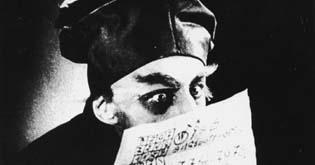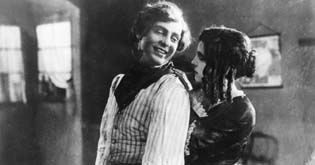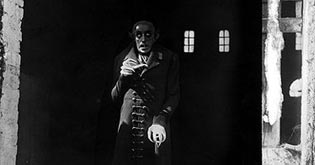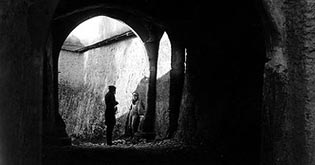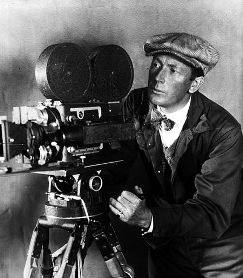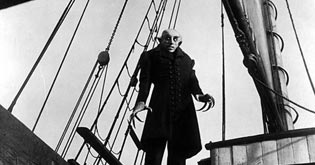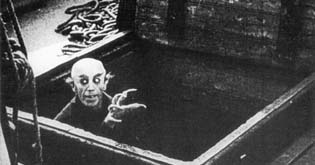Live Recording by Wilfried Kaets
Short and Sweet
Silent film classic based on themes from Bram Stoker’s horror novel *Dracula*. Count Orlok contacts the real estate agent Knock to purchase a house in Wisborg. Knock then sends his secretary Hutter to Transylvania to finalize the deal with the Count. Hutter’s wife Ellen fears the worst before his departure. After a long journey, Hutter arrives at the Count’s eerie castle.
Upon waking the next morning, Hutter discovers strange bite marks on his neck but is still unaware of the horror he faces. During the contract signing, the Count comes across a picture of Ellen and becomes captivated by her beautiful neck. The next day, Hutter investigates the castle and finds Orlok sleeping in a coffin. Observing the Count’s unsettling departure that evening, Hutter, concerned for his wife, hastily leaves the castle. A life-and-death race begins…
Nosferatu is considered a precursor to countless vampire and horror films. Filmed during the silent era, it set standards for future generations of directors.
Murnau masterfully used the medium’s techniques to convey horror from the unfamiliar to the familiar setting. Nature, the houses, and especially Nosferatu himself are imbued with a haunting quality. Murnau’s expressive visual language is striking compared to contemporary films.
The film’s naturalistic settings and understated portrayal bring it very close to modern productions.
Music
New Music for Piano and Harpsichord: Wilfried Kaets
The music is designed as a homage to the grand silent film scores of the 1920s. It combines elements typical of the time, such as a mixture of compilation (using pre-existing music) and composition. The aim is for the music to evoke the sound of 1921 in a cinema with a typical cinema musician at the piano or theater organ, thus providing the audience with a distinctive period and emotional atmosphere.
In addition, there are sections of newly composed music designed as fixed or moment-specific modules. These serve both to link the compiled sections and to provide certain scenes with a unique musical dramatic mood.
Register
**Friedrich Wilhelm Murnau** (also F. W. Murnau, born December 28, 1888, as Friedrich Wilhelm Plumpe in Bielefeld; died March 11, 1931, in Santa Barbara, California) is regarded as one of the most significant German film directors of the silent film era. His work, influenced by Expressionism, his psychological imagery, and his then-revolutionary camera and editing techniques, opened up entirely new possibilities for the young medium of film.
In 1919, Murnau returned to Berlin and began working in film. His highly fruitful collaboration with screenwriter Carl Mayer started with the film *The Hunchback and the Dancer*, and Mayer went on to write scripts for six more of Murnau’s films. His most famous film from this period is *Nosferatu: A Symphony of Horror* (1922), starring Max Schreck in the title role. It was an adaptation of Bram Stoker’s *Dracula* but had to be renamed due to licensing issues.
In 1924, he directed *The Last Laugh* for UFA, in which Emil Jannings plays a hotel doorman who is demoted to a lavatory attendant and falls apart. The “unshackled” or “flying” camera used by Murnau and cinematographer Karl Freund in this film liberated the camera from its static position and enabled entirely new perspectives (e.g., to follow the smoke of a cigarette, Freund mounted the camera on a fire ladder and moved it).
Additionally, Murnau introduced the “subjective camera” in this film, which depicts events from the viewpoint of a character. Murnau’s ability to tell a story using purely cinematic means is also demonstrated by his near-total omission of intertitles in this film, which was highly unusual for the silent film era.
Murnau concluded his series of German films in 1926 with *Tartuffe* (based on Molière) and *Faust: A German Folk Legend*.
Murnau’s successes in Germany, especially the American version of *The Last Laugh* in 1925, caught Hollywood’s attention. He received a contract offer from American producer William Fox, who promised him full artistic freedom. Murnau’s first film made in the USA, *Sunrise: A Song of Two Humans* (1927), won three Oscars at the very first Academy Awards but did not fully meet commercial expectations. Due to this and the increasingly difficult economic situation at Fox and Hollywood’s transition to sound films, Murnau faced growing interference with his artistic vision in his subsequent films. He was even replaced as director on *City Girl*, which had a sound version added without his involvement.
Disappointed by Hollywood’s constraints, Murnau terminated his contract with Fox in 1929. After an unsuccessful attempt to rejoin UFA in Berlin, he bought a sailing yacht, determined to make his next film entirely on his own terms. He went to Tahiti to shoot *Tabu* with director and documentary filmmaker Robert J. Flaherty. During production, significant issues arose with the film’s financing. Murnau eventually parted ways with Flaherty, who had stronger documentary ambitions, and financed the film himself. Shot exclusively on the island of Bora Bora with local non-professional actors, the film became a stylistically influential blend of documentary and melodrama. Paramount, impressed by the film, took on its distribution and offered Murnau a ten-year contract. However, Murnau did not live to see the film’s premiere on March 18, 1931, as he died in a car accident.
**Films by Friedrich Wilhelm Murnau**
A selection of films performed live with music by Wilfried Kaets:
– 1921: Schloß Vogelöd
– 1922: The Burning Soil
– 1922: Nosferatu: A Symphony of Horror
– 1922: Phantom
– 1924: The Finances of the Grand Duke
– 1924: The Last Laugh
– 1926: Tartuffe
– 1926: Faust: A German Folk Legend
– 1927: Sunrise: A Song of Two Humans
– 1930: City Girl
– 1931: Tabu

